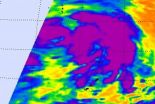(Press-News.org) CAMBRIDGE, MA -- The colorful leaves piling up in your backyard this fall can be thought of as natural stores of carbon. In the springtime, leaves soak up carbon dioxide from the atmosphere, converting the gas into organic carbon compounds. Come autumn, trees shed their leaves, leaving them to decompose in the soil as they are eaten by microbes. Over time, decaying leaves release carbon back into the atmosphere as carbon dioxide.
In fact, the natural decay of organic carbon contributes more than 90 percent of the yearly carbon dioxide released into Earth's atmosphere and oceans. Understanding the rate at which leaves decay can help scientists predict this global flux of carbon dioxide, and develop better models for climate change. But this is a thorny problem: A single leaf may undergo different rates of decay depending on a number of variables: local climate, soil, microbes and a leaf's composition. Differentiating the decay rates among various species, let alone forests, is a monumental task.
Instead, MIT researchers have analyzed data from a variety of forests and ecosystems across North America, and discovered general trends in decay rates among all leaves. The scientists devised a mathematical procedure to transform observations of decay into distributions of rates. They found that the shape of the resulting curve is independent of climate, location and leaf composition. However, the details of that shape — the range of rates that it spans, and the mean rate — vary with climatic conditions and plant composition. In general, the scientists found that plant composition determines the range of rates, and that as temperatures increase, all plant matter decays faster.
"There is a debate in the literature: If the climate warms, do all rates become faster by the same factor, or will some become much faster while some are not affected?" says Daniel Rothman, a co-founder of MIT's Lorenz Center, and professor of geophysics in the Department of Earth, Atmospheric and Planetary Sciences. "The conclusion is that all rates scale uniformly as the temperature increases."
Rothman and co-author David Forney, a PhD graduate in the Department of Mechanical Engineering, have published the results of their study, based largely on Forney's PhD thesis, in the Journal of the Royal Society Interface.
Litter delivery
The team obtained data from an independent 10-year analysis of North
American forests called the Long-term Intersite Decomposition Experiment Team (LIDET) study. For this study, researchers collected leaf litter — including grass, roots, leaves and needles — from 27 locations throughout North and Central America, ranging from Alaskan tundra to Panamanian rainforests.
The LIDET researchers separated and weighed each litter type, and identified litter composition and nutrient content. They then stored the samples in porous bags and buried the bags, each filled with a different litter type, in each of the 27 geographic locations; the samples were then dug up annually and reweighed. The data collected represented the mass of litter, of different composition, remaining over time in different environments.
Forney and Rothman accessed the LIDET study's publicly available data online, and analyzed each dataset: the litter originating at one location, subsequently divided and distributed at 27 different locations, and weighed over 10 years.
The team developed a mathematical model to convert each dataset's hundreds of mass measurements into rates of decay — a "numerically delicate" task, Rothman says. They then plotted the converted data points on a graph, yielding a surprising result: The distribution of decay rates for each dataset looked roughly the same, forming a bell curve when plotted as a function of the order of magnitude of the rates — a surprisingly tidy pattern, given the complexity of parameters affecting decay rates.
"Not only are there different environments like grasslands and tundra and rainforest, there are different environments at the microscale too," Forney says. "Each plant is made up of different tissues … and these all have different degradation pathways. So there's heterogeneity at many different scales … and we're trying to figure out if there's some sort of commonality."
Common curves
Going a step further, Forney and Rothman looked for parameters that affect leaf decay rates. While each dataset resembled a bell curve, there were slight variations among them. For example, some curves had higher peaks, while others were flatter; some curves shifted to the left of a graph, while others lay more to the right. The team looked for explanations for these slight variations, and discovered the two parameters that most affected the details of a dataset's curve: climate and leaf composition.
In general, the researchers observed, warmer climates tended to speed the decay of all plants, whereas colder climates slowed plant decay uniformly. The implication is that as temperatures increase, all plant matter, regardless of composition, will decay more quickly, with the same relative speedup in rate.
The team also found that plant matter such as needles that contain more lignin — a sturdy building block — have a smaller range or decay rates than leafier plants that contain less lignin and more nutrients that attract microbes. "This is an interesting ecological finding," Forney says. "Lignin tends to shield organic compounds, which may otherwise degrade at a faster rate."
Rothman adds that in the future, the team may use the model to predict the turnover times of various ecosystems — a finding that may improve climate change models, and help scientists understand the flux of carbon dioxide around the globe.
"It's a really messy problem," Rothman says. "It's as messy as the pile of leaves in your backyard. You would think that each pile of leaves is different, depending on which tree it's from, where the pile is in your backyard and what the climate is like. What we're showing is that there's a mathematical sense in which all of these piles of leaves behave in the same way."
INFORMATION:
Written by Jennifer Chu, MIT News Office
END
After a series of Philadelphia hospitals started closing their maternity units in 1997, infant mortality rates increased by nearly 50 percent over the next three years. The mortality rates subsequently leveled off to the same rate as before the closures, but pediatric researchers say their results underscore the need for careful oversight and planning by public health agencies in communities experiencing serious reductions in obstetric services.
Between 1997 and 2007, 9 of 19 obstetric units closed in Philadelphia, resulting in 40 percent fewer obstetric beds. Other research ...
A simple new test, in which the patient swallows a string, can monitor treatment of eosinophilic esophagitis as effectively as an invasive, expensive and uncomfortable procedure that risks complications, particularly in children.
Researchers from the University of Illinois at Chicago College of Medicine, working in collaboration with clinician-investigators at the University of Colorado Denver/Children's Hospital Colorado and Lurie Children's Hospital in Chicago, reported their findings in a study published recently online in the journal Gut.
Eosinophilic esophagitis, ...
MAYWOOD, Ill. – Gender-specific group therapy is effective for treating depressed women with Type 2 diabetes, according to a study published in the latest issue of the Annals of Behavioral Medicine and funded by the National Institute of Nursing Research. Evidence suggests that antidepressants may disrupt blood-sugar control and can be associated with increased weight gain; therefore, other treatment options are needed for depression.
"Using antidepressants to treat depression, although important, can be associated with side effects that make compliance an issue for people ...
Amsterdam, The Netherlands, October 3, 2012 – Milk consumption has been linked to improved health, with decreased risks of diabetes, metabolic syndrome, and colon cancer. A group of scientists in Sweden found that lactoferricin4-14 (Lfcin4-14), a milk protein with known health effects, significantly reduces the growth rate of colon cancer cells over time by prolonging the period of the cell cycle before chromosomes are replicated. In a new study, investigators report that treatment with Lfcin4-14 reduced DNA damage in colon cancer cells exposed to ultraviolet (UV) light. ...
STANFORD, Calif. — Not everyone is able to be hypnotized, and new research from the Stanford University School of Medicine shows how the brains of such people differ from those who can easily be.
The study, published in the October issue of Archives of General Psychiatry, uses data from functional and structural magnetic resonance imaging to identify how the areas of the brain associated with executive control and attention tend to have less activity in people who cannot be put into a hypnotic trance.
"There's never been a brain signature of being hypnotized, and we're ...
The fifteenth tropical depression of the Atlantic Ocean hurricane season was born on Oct. 3 an NASA's Terra satellite captured an image of it as it came to be.
NASA's Terra satellite passed over newborn Tropical Depression 15 on Oct. 3 at 8:52 a.m. EDT in the central Atlantic Ocean and the Moderate Resolution Imaging Spectroradiometer (MODIS) instrument captured an image of the storm. Shortly after the image was created, forecasters at the National Hurricane Center looking at the MODIS and other satellite data determined that the low pressure area had become a depression.
On ...
NASA's Aqua satellite took an infrared "picture" of Tropical Storm Maliksi in the western North Pacific Ocean and identified the strongest part of the storm being east of its center.
On Oct. 3 at 1500 UTC (11 a.m. EDT), Tropical storm Maliksi had maximum sustained winds of 45 knots (51.7 mph/83.3 kph). It was located about 470 nautical miles (541 miles/870.4 km) south-southeast of Tokyo, Japan, near 29.4 North and 143.1 East. Maliksi was speeding to the north-northeast at 21 knots (24.1 mph/38.8 kph).
The Atmospheric Infrared Sounder (AIRS) instrument that flies ...
VIDEO:
On Oct. 2 at 11:43 p.m. EDT, heavy convective thunderstorms were found in Nadine's northeastern quadrant by NASA's Tropical Rainfall Measuring Mission (TRMM) satellite. Wind shear had separated the center...
Click here for more information.
NASA satellites continue to gather data from Tropical Storm Nadine on its twenty-second day of life in the eastern Atlantic as it threatens the Azores again. NASA data has shown that wind shear is pushing the bulk of clouds and ...
Tropical Storm Gaemi is packing a lot of power around its middle and on one side of the storm, and that was apparent in NASA satellite imagery.
NASA's Terra satellite passed over Tropical Storm Gaemi on Oct. 3 at 0300 UTC (11:00 p.m. EDT, Oct. 2) and the Moderate Resolution Imaging Spectroradiometer (MODIS) instrument captured a true-color image of the storm. The image showed a bright white, rounded area around the center that indicated higher, stronger thunderstorms. Higher, stronger thunderstorms also wrapped around the center in a wide band that stretches from north ...
JUPITER, FL, October 3, 2012 – Scientists from the Florida campus of The Scripps Research Institute have developed a novel technology that can identify, in animal models, potential biomarkers of ulcerative colitis, a type of inflammatory bowel disease that affects the lining of the colon.
The study was published October 3, 2012, in the Journal of the American Chemical Society.
The new research focuses on the protein arginine deiminases (PAD), which have been implicated in a number of diseases, including cancer, multiple sclerosis and rheumatoid arthritis. PADs participate ...




